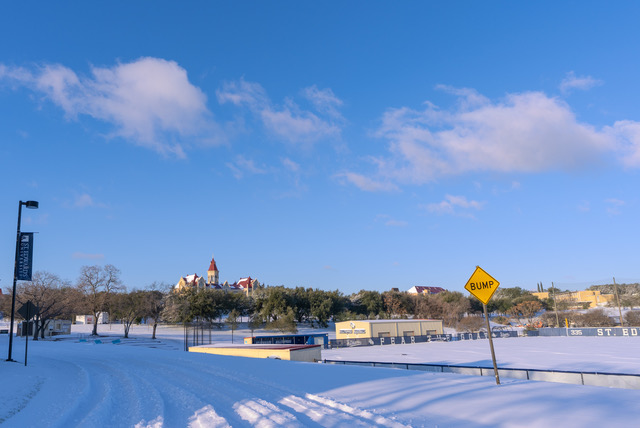OPINION: Historic winter storm affected all Texans, especially the vulnerable
The winter storm blanketed Central Texas with 5-7 inches of snow.
When cold breezes blew in from the North last Thursday, February 11, Texans had no idea of how treacherous the weather they were about to experience would be. The following Monday held what at first seemed like a simple snow day to keep schools closed momentarily, and families out in their yards began building snowmen and making snow angels. But once people began to lose power, heat and water, things became much more serious.
After the initial winter storm that brought the first layer of snow and icicles Sunday night, people all over the state began to complain about power outages and frozen pipes. The state had come to terms with the fact they were facing a situation they haven’t had to deal with before. It was also becoming apparent that Texas seemed to be the only state experiencing what was called the “Texas blackout.” A map put together by The New York Times shows Texans getting the worst of the winter storm effects, with power outages being the most severe.
Here in Austin, residents raced to H-E-B grocery stores in an attempt to stock up their houses before roads became too dangerous to drive in. Pictures showed East Austin in pitch black, and businesses, like restaurants and other non-essential stores, shut their doors. In my parent’s home, where I thankfully arrived before conditions worsened, we feared the eventual explosion of frozen pipes in the walls and ceilings.
The neighborhood my parents live in is located in Lakeway, Texas, which is known for its close location to Lake Travis and its warm weather (ironic, right?). The neighborhood was one of the lucky few to never lose power, but those surrounding us weren’t as lucky. My good friend and college roommate who was also staying with her parents in Steiner Ranch, a community off of Ranch Road 620 in West Austin, experienced a power outage in her apartment complex on Tuesday, Feb. 16, which shut off not only their fridge and cooking appliances but also their heat.
I sat in my toasty house wishing there was something I could do. People like her were not only having to double up on clothes in their own homes but were also running low on food with no way of reaching nearby grocery stores. Even worse was the knowledge that there were others in worse situations than her and me, possibly running low on drinking water.
After the first two days of statewide power outages, people began to speak out online and demand answers from someone, anyone. On Feb. 17, ERCOT, the company that controls all of Texas’ power, stated that 3.4 million customers were still without power. Governor Greg Abbott had even stated his anger with how unprepared ERCOT was and began to try and find solutions. Unfortunately, those solutions he and other government officials were seeking weren’t helping what Texans were experiencing in real-time.
As well as the power outages, households were then told to drip faucets, conserve and even boil water as “precautionary measures.” Those who were unable or unwilling to do so might experience frozen pipes, which could then lead to pipes bursting. On Feb. 15, my parents and I sat comfortably in our living room when a pipe that had frozen upstairs finally thawed out enough to explode. Water came spewing into our entryway, living room and dining room, and we desperately tried to find the shut-off valve buried underneath snow outside. My step-mom and I began filling up five-gallon buckets with the pressurized water spilling into the house in an attempt to reduce the flooding. Thankfully, the fire department didn’t need to get involved, but I couldn’t help but wonder how those without homeowner’s insurance were going to be able to afford to fix their homes when a catastrophe like this hit.
Several places, like churches and even St. Edward’s University, opened their doors as warming centers for those who were either on the streets and in search of heat, or even families willing to travel outside their frigid homes to seek warmth. Salt trucks did their best to limit the amount of danger on roadways, and although states like Texas are not equipped for weather like this, everyone did as well as possible. Northerners expressed sympathy on social media and even offered up advice for ensuring as much heating as possible when dealing with power outages, frozen pipes and even salting driveways and sidewalks.
This past week was definitely a huge learning experience for all of the south, especially Texas residents, and I am thankful my family and I, as well as my roommate and her family, were able to make it through safely. My heart goes out to those who may still be facing the negative effects of this storm and I wish everyone who is having to deal with things like home and car repairs the best.
Some more resources can be found below:

Claire is a senior Communication major with a minor in Journalism continuing to dedicate her time growing and learning as a student journalist. Claire...







